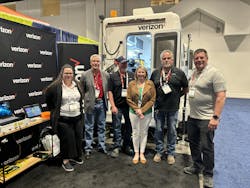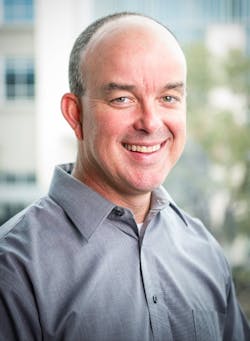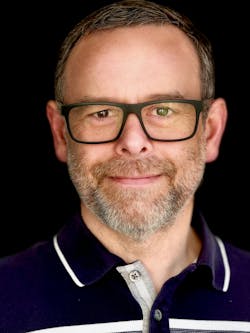Executive Insights With ISE EXPO’s Tech Talk Presenters
These leaders have walked in your shoes and have the scars to show it. Thankfully, these professionals have distilled their years of experience into network evolution wisdom to help your team perform better and help you achieve your professional goals.
Diana Scudder, Vice President, Virtual Network Operations & Engineering, Verizon
ISE: Why should attendees come to YOUR Tech Talk presentation?
Scudder: In a world of exponentially increasing demand for data, the reality is that demand is competing with the need to reduce the overall cost to serve. The audience will learn how network virtualization can help with that. Virtualizing network functions allows teams to stay ahead of growing capacity demands and increased work volumes, in a way that helps drive efficiency, as networks expand. This discussion will offer insights into potential challenges that network providers may encounter along the way and suggestions for how to overcome them.
Topic: Biggest Challenges
ISE: What are two significant tactical challenges you and your team face regarding network evolution/transformation?
Scudder: One significant tactical challenge regarding network evolution/transformation is potential delays with the global supply chain. This challenge is managed and mitigated with accurate forecasting and timely communication with suppliers. Another significant challenge is attracting and retaining talent in a competitive workforce. To retain talent, fostering a culture of curious learning and continuous upskilling is critical to motivate employees to evolve with the network and technology.
Topic: Operational Realities
ISE: ICT industry analysts and observers often focus on CapEx budgets. But the reality is that OpEx can make or break the bottom line. Share two things your team does to control OpEx.
Scudder: The key to controlling OpEx is to implement network solutions that deliver high-quality performance and reliability that cost less to build (capital) and maintain (operating expense). My team achieves this by virtualizing our network functions to deliver high quality performance and reliability at a fraction of the operating cost of purpose-built physical network functions. Another way we reduce our operating expenses is by owning and operating a private cloud network leveraging “common off the shelf” hardware and avoiding monthly recurring costs associated with leveraging a public cloud.
Topic: The Future
ISE: What emerging or disruptive broadband technology excites you the most? Why?
Scudder: I am most excited about the disruptive broadband technology of fixed wireless access leveraging Verizon’s 5G Ultra Wideband network. This technology delivers the most reliable and secure broadband connectivity to more consumers and businesses in more places.
Topic: Vendor Collaboration
ISE: What three things do you need from your vendor partners?
Scudder: What we need from our vendor partners is high-quality software code, timely delivery of new features and functionality, and a strong sense of urgency to address any software bugs and defects when they arise. One of the most important ways to ensure quality assurance of new code is for our vendor partners to configure their labs to match our production environment. Additionally, it is imperative that thorough regression testing be performed before delivery.
Topic: Advice
ISE: What would you tell emerging leaders as they try to make a difference in the industry AND propel their careers to the next level?
Scudder: My recommendation for emerging leaders is not to be afraid to take risks. Leaders need to get comfortable with being uncomfortable. They must become experts at change management. First, by embracing change themselves. Next, by helping lead their team through change.
Technology is changing and evolving at such a rapid and unprecedented rate. Industry leaders must embrace new technologies and innovation, such as artificial intelligence.
Finally, leaders must also create a safe environment for their employees to feel empowered to share ideas, try, fail, learn, iterate, and grow. Leaders must remember that some of the most innovative and creative solutions are developed by frontline teams.
Biography
Diana Scudder leads a team of highly technical professionals responsible for designing, engineering, and operating a large private cloud and all the virtual network functions and applications associated with wireless and wireline services for consumers and large enterprise customers. She has 27 years of experience in technology and telecommunications with global leadership experience in engineering, operations, program management, budget management and implementation of both physical and virtual network solutions. www.verizon.com
Todd Zeiler, Vice President of Wireless Construction & Engineering, AT&T
ISE: Tell attendees why they should come to YOUR Tech Talk presentation.
Zeiler: Together, we’ll explore the transformative power of modernization and envision a future where connectivity reshapes our world, powered by openness and innovation.
Topic: Biggest Challenges
ISE: What are two significant tactical challenges you and your team face regarding network evolution/transformation?
Zeiler: “We can dance if we want to” might be a famous quote from a song, but it’s also a fair point as we journey towards the end of this decade. Today, cellular phones and Wi-Fi don’t dance very gracefully; they often step on each other’s feet. To allow for a more consistent experience, we must partner to drive an ecosystem from a device all the way through the core. Wi-Fi is here to stay, and the average consumer is rarely aware when they are on Wi-Fi vs. a mobile cellular network while indoors. True convergence will enable a consistent customer experience while creating more cost-efficient operations.
Topic: The Future
ISE: What emerging or disruptive broadband technology excites you the most? Why?
Zeiler: While Open RAN usually gets the attention of the newspaper's front page, the service management and orchestration (SMO) platform is the foundation of creativity. While “open network management” might not do justice to the full scope of SMO, let’s offer that label as a starting point. While SMO will offer the traditional configuration, fault, and performance management of a multi-vendor environment, I would provide the real win is potentially an “app store” for wireless networks. The “SMO app store” will invite the brightest minds of mobile network engineers, wireless vendor partners, and, ultimately, the creativity of the brightest third-party developers to drive automation, innovation, and out-of-the-box ideation for revenue-generating applications.
Topic: Vendor Collaboration
ISE: What three things do you need from your vendor partners?
Zeiler: We need transparency and authenticity from our partners, and we must be held accountable for “living transparency and authenticity” first.
Topic: The Elephant in the Room
ISE: What is the industry NOT addressing that it should related to network evolution and delivering high-speed broadband for all?
Zeiler: One of my favorite songs includes the lyrics “This is the air I breathe.” While the song was not written about the future of wireless spectrum, our users are breathing more and more “air” with their favorite use cases and applications.
Mobile wireless carriers need sufficient allocations of “network grade spectrum.” It’s essential to understand not all air (spectrum) is created equally. Ideal spectrum includes large, contiguous channel sizes at full power, to allow for higher data rates and test-driven development operations to increase efficiencies in 5G; ideally in the sub 8-10GHz space. Without newly unlocked spectrum, wireless operators will be in a never-ending chase to “densify” their way out of the congestion. The cost of this “elephant in the room” is not scalable.
Topic: Emotional Intelligence
ISE: As you work through network obstacles, what have you learned about yourself and others that surprised you?
Zeiler: One of my leaders once said, “If I could hire based on self-awareness alone, that would be enough for me to build a strong team.” Since hearing that, I’ve been extra aware of the need to grow that trait as a leader, both in and outside work. We all are created with inherited strengths and are gifted in some areas more than others. I’ve learned that our strengths can also be our potential downfalls.
Out-front and upfront leaders can be a huge inspiration but can also struggle with pride. Individual contributors with deep knowledge of a particular subject make significant contributions to the advancement of society but can also need help collaborating and sharing ideas. The best leaders are self-aware and are emotionally the most intelligent. I’ll never forget that life is 10% what happens to you and 90% how you react.
Topic: Advice
ISE: What would you tell emerging leaders as they try to make a difference in the industry AND propel their careers to the next level?
Zeiler: Great leaders don’t set out to be leaders; they set out to make a difference. It’s never about the role, but it’s always about the goal! The strongest leaders are already leading at the “next level” well before their new title is awarded. We are constantly on the “scout team” to discover the leader who can take the highly complex “tree” and tell the bigger picture story about “the forest.” What is the “so whAT&T”?
Biography
In November 2021, Todd transitioned to a role over HQ Radio Access Engineering and Construction where his new team has responsibilities for optimization, standardization, best practices, design, emerging technologies, RAN strategy, compliance, in-building, traffic forecasting, and FirstNet interfaces. He has 30+ years in industry experience and has held positions in outside plant, wireless operations, RF engineering, RF performance, systems automation, equipment engineering, project management, mobility core planning, M&A projects, in-building mobility, Director for Georgia Radio Access Network, CTO Wireless Architecture Organization overseeing 5G and FirstNet architecture, intercarrier architecture and operations, and now overseeing the HQ Wireless Construction and Engineering team. www.att.com
David Curran, Vice President, Network Architecture, Frontier Communications
ISE: Why should attendees come to YOUR Tech Talk presentation?
Curran: What if we've been getting customer satisfaction all wrong? We've been assuming that no news is good news, but the truth is, customers often experience problems long before they call in or switch to a competitor. It's time to get proactive about identifying and fixing issues, even when there are no complaints. And when outages do happen, let's make sure we're not leaving anyone behind. It's time to put the customer at the center of our approach.
That’s why you should attend my Tech Talk titled “What You Don’t Know Can Hurt You.”
Biography
With a telecommunications career spanning over two decades, David has held many roles in Network Engineering, Operations, and IT. After joining Frontier Communications in 2014 he worked in diverse areas such as NG911, network automation, and network strategy. Since 2019, David has led the Network Architecture team and its Fiber Innovation Lab where he leads teams that design, test, and certify all new voice, broadband, core, transport, and wireless technologies. Recently integrating data science and network analytics into his purview, David and his team are at the forefront of revolutionary work in network analytics and health, driven by customer experience insights. www.frontier.com
About the Author
Sharon Vollman
Content Ambassador for ISE EXPO
Sharon Vollman is the Content Ambassador for ISE EXPO. She is passionate about collaborating with thought leaders, SMEs and hard-working doers who design, plan and deploy ultra-reliable broadband networks. Vollman is committed to creating a variety of educational offerings for ISE EXPO attendees that inspire them to connect every U.S. citizen with the broadband networks we all want for our children and grandchildren.
Vollman has created educational partnerships with Broadband Service Providers including AT&T, Verizon, Lumen, Frontier Communications and others. She has covered the telecom industry since 1996.






